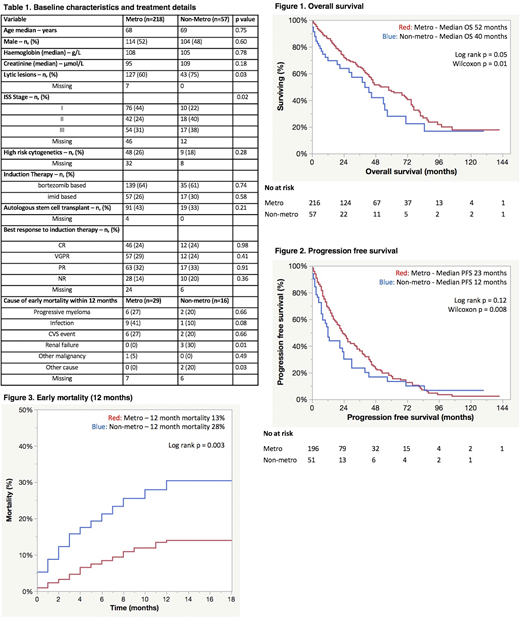Introduction: Australia's largest state, Western Australia (WA), comprises a land area of more than 2.5 million square kilometres, an area than larger than that of Texas and Alaska in the United States combined, with a population of more than 2.6 million. Whilst a large proportion of Western Australians live in the capital city Perth, approximately 20% are dispersed across the state in regional and remote areas. The diagnosis and treatment of myeloma require specialist Haematologist management and frequent follow-up. Access to Haematology specialist services and treatment in WA is centred in metropolitan Perth, with outreach services visiting regional and remote areas limited in location and frequency. Some patients are required to travel long distances or relocate to access treatment. The aim of our study was to assess difference in clinical presentation, treatment and outcomes of myeloma patients living in regional or remote Western Australia compared to metropolitan Perth.
Methods: A retrospective chart review of new cases of symptomatic multiple myeloma diagnosed between January 2008 and December 2019 and referred to Royal Perth Hospital and Fiona Stanley Hospital, two tertiary metropolitan hospitals was conducted. Data was obtained regarding patient demographics, disease characteristics, treatment, response and survival outcomes, through review of patient paper and electronic medical records. Patients were grouped into those living inside or outside the Perth metropolitan area (metro or non-metro) according to area codes obtained from the WA government data suite.
Results: Two hundred and seventy-five cases were identified, 218 (79%) metro and 57 (21%) non-metro. Baseline characteristics for the two groups are listed in Table 1. The median age at diagnosis was 68.4 years (range 30-91.5 years) and 47% were female, with no significant difference between the groups. There were a higher number of patients with lytic bone disease at diagnosis in the non-metro cohort (75.4% non-metro vs 60.2% metro, p=0.03) as well as a higher proportion of patients with international staging system (ISS) stage II or III disease (77.8% non-metro vs 55.8% metro, p=0.005). Sixty three percent of patients overall received first line bortezomib based therapy and 27% first line imid based therapy, with no significant difference by location. Overall 41% of patients underwent autologous stem cell transplantation, 70% of those ≤70 years of age, with no significant difference between the groups (33.3% non-metro vs 42.5% metro, p=0.21). The median overall survival (OS) was 47 months for the entire cohort. Survival was lower in the non-metro cohort, although this did not reach statistical significance (median OS 52 months for metro vs 40 months for non-metro, p=0.05) Figure 1. Progression free survival (PFS) was similar between the two groups (median PFS 23 months metro vs 12 months non-metro, p=0.12) Figure 2. Early mortality at 6 and 12 months was higher in the non-metro cohort (Six-month mortality was 21.1% non-metro vs 8.3% metro, p=0.01. Twelve-month mortality was 28.1% non-metro vs 13.4% metro, p=0.01) Figure 3. There was a trend in cause of early mortality due to infection being higher in the metro cohort, and cause of early mortality due to renal failure being higher in the non-metro cohort, Table 1.
Conclusions: In our cohort, patients living in non-metropolitan locations were more likely to present with higher ISS stage and lytic lesions at diagnosis. Rates of early mortality were significantly higher in the non-metropolitan cohort. There was a trend towards shorter overall survival although this did not meet statistical significance. These differences may represent delays in clinical presentation and diagnostic workup and highlight the need for optimisation of follow up of patients in non-metropolitan areas particularly during the early time period post diagnosis. Periods of resource constraint and travel restrictions as is faced currently may accentuate these disparities. In addition, the nature of myeloma therapy is evolving with addition of treatments requiring expertise to deliver, such as monoclonal antibodies and chimeric antigen receptor T cells. As these therapies become commercial further studies are needed to assess adequacy of access for patients from non-metropolitan centres.
Leahy:Pfizer: Membership on an entity's Board of Directors or advisory committees. Sidiqi:Celgene: Honoraria, Other: Travel grant; Amgen: Honoraria; Janssen: Honoraria.
Author notes
Asterisk with author names denotes non-ASH members.


This feature is available to Subscribers Only
Sign In or Create an Account Close Modal